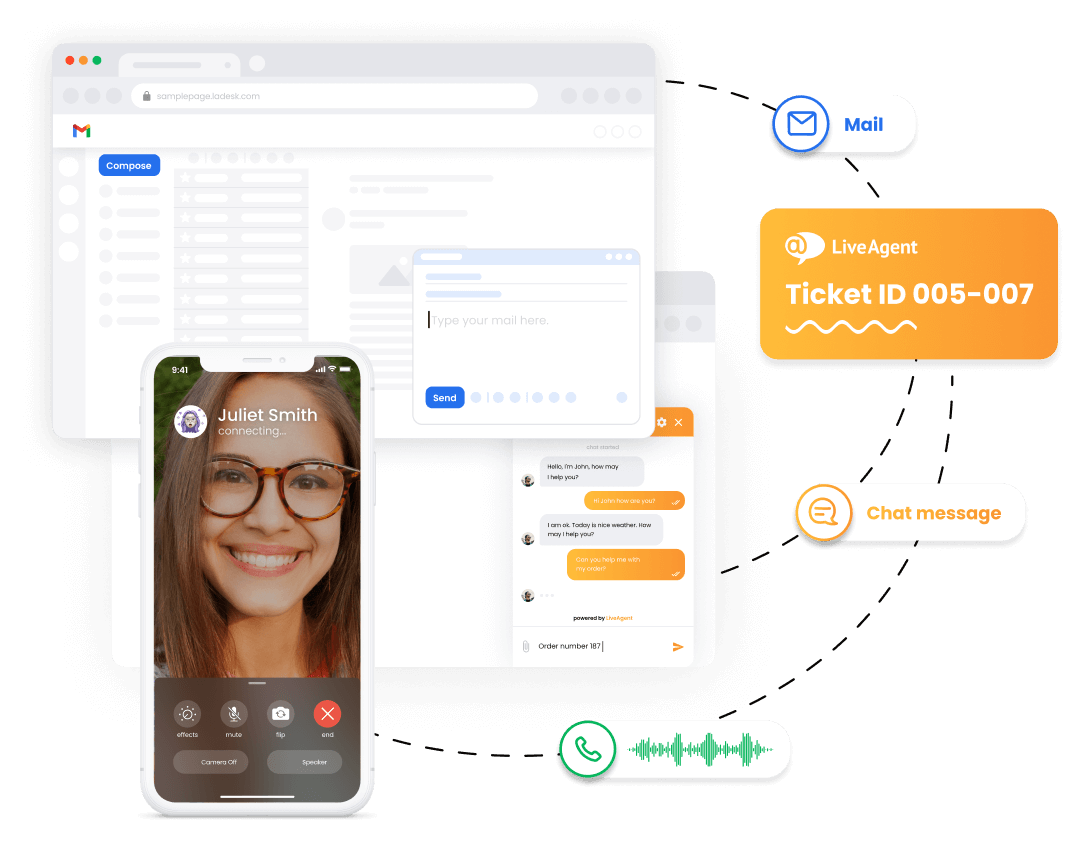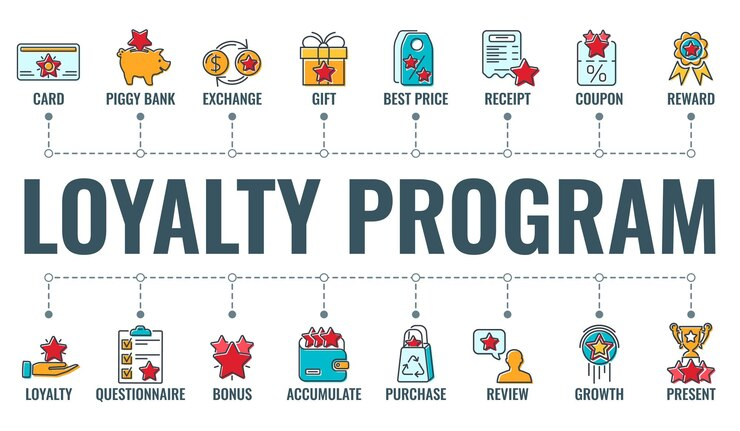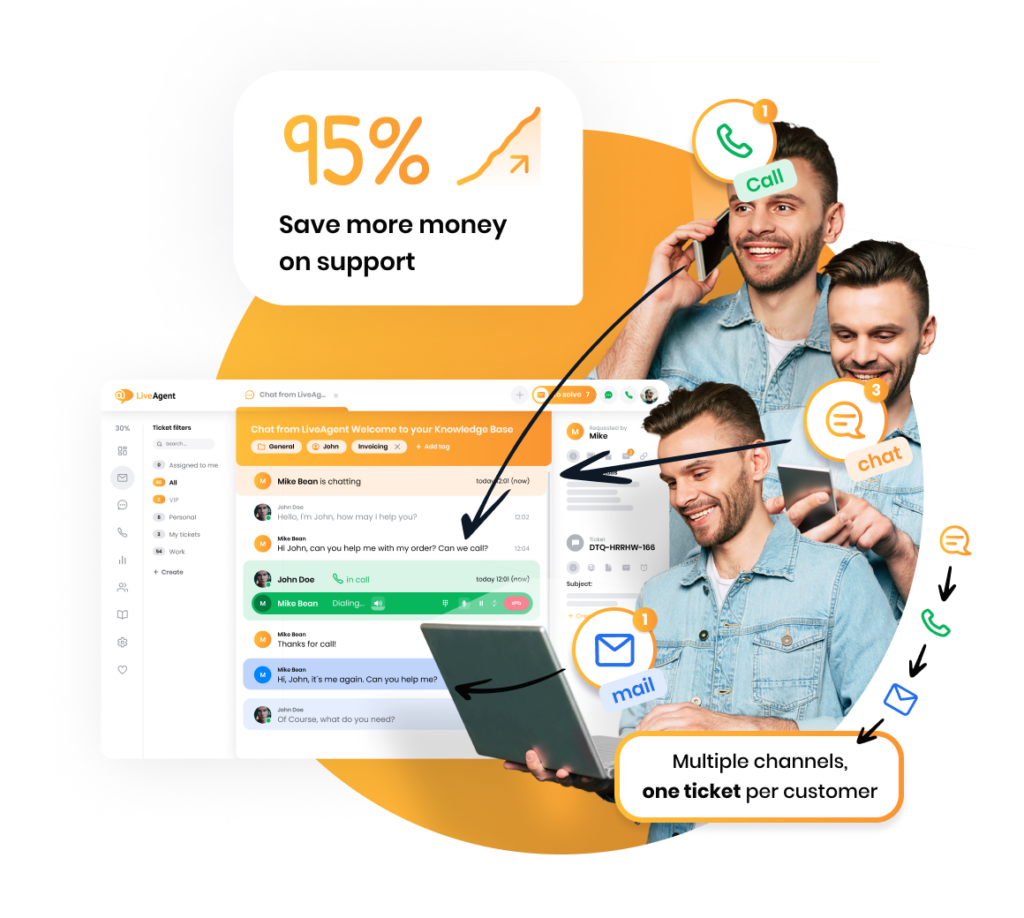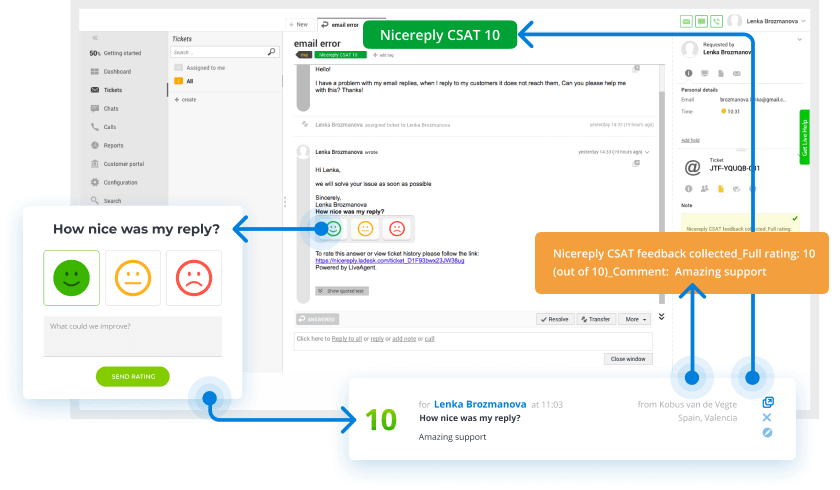Understanding how to motivate customers is essential for businesses striving to thrive. Customer incentives are powerful tools that can effectively increase engagement and drive sales, but how can they be implemented for maximum impact?
Customer incentives come in various forms, ranging from monetary rewards to exclusive benefits that enhance customer loyalty and satisfaction. The key is knowing how to tailor these incentives to fit the unique needs of your target audience, thus fostering a deeper connection with your brand.
This article will delve into the definition of customer incentives, explore different types, and provide concrete examples of effective programs. We will also discuss strategies for designing and measuring the success of your incentive strategies, introducing LiveAgent as a top solution for streamlining these efforts and solving reader challenges.
What are customer incentives?
Customer incentives are rewards offered by brands to encourage customers to engage in beneficial actions. These incentives can include reward points, discounts, freebies, advance access to new products, or exclusive sales. The main goal is to promote more interaction between the customer and brand.
A well-implemented customer incentive program can boost customer loyalty, increase user-generated content, and attract new referral customers. These programs work by tapping into customers’ desire for deals, often at a low cost to the business. By doing so, customers become marketers for the brand themselves.
Effective customer incentives can gather market insights, improve brand reputation, and create positive experiences. Overall, they significantly contribute to business growth.
Differences between monetary and non-monetary incentives
Monetary incentives offer tangible benefits, such as discounts, cashback, or loyalty points. These directly affect what customers can afford.
Non-monetary incentives, however, provide perks without direct financial impact. Examples include exclusive access to sales or early product releases. Both monetary and non-monetary incentives are vital in motivating customers to stay loyal.
Both types of incentives help create positive experiences. This is important for standing out in a crowded market. Effective incentive programs, using both types, enhance loyalty and engagement by providing value and appreciation.
| Type of Incentive | Example | Effect on Customer |
|---|---|---|
| Monetary | Discounts, Cashback | Direct impact on purchases |
| Non-Monetary | Exclusive Access, Freebies | Enhances engagement |
To develop strong customer relationships, implementing effective incentive programs is essential. For businesses looking to optimize these strategies, LiveAgent offers tools that can manage and improve customer interactions seamlessly. By using LiveAgent, you can boost your customer satisfaction, retention rate, and overall engagement.

Types of customer incentives
Customer incentives are powerful tools to encourage brand loyalty and engagement. They motivate customers to return and even attract new ones. These incentives can be rewards points, discounts, freebies, or exclusive access to products or sales. When done right, they foster customer loyalty, enhance satisfaction, and provide valuable insights into customer behavior.
Successful programs see higher customer retention rates, which are crucial as acquiring new customers costs more than retaining current ones. Brands can also encourage customers to act as ambassadors through incentives, driving positive referrals and user-generated content.
Loyalty programs
Loyalty programs are a staple in enhancing customer relationships. They reward loyal customers for their ongoing support. Customers often earn points for purchases or engagements, redeemable for exclusive perks or personalized offers. Tiered systems can further motivate participation by categorizing customers and offering different rewards. Non-monetary incentives, like access to special events, can also enhance the customer experience. Designing these programs requires understanding customer preferences and offering flexible rewards, broadening appeal, and boosting retention.

Referral bonuses
Referral bonuses boost customer engagement and acquisition. They reward current customers who refer new clients to a brand, benefiting both parties. These bonuses can include monetary rewards or product-specific incentives. This approach shows appreciation and encourages more referrals. Typical rewards could be discounts, cash bonuses, or points that can be redeemed later. Companies might also offer small gifts or gift cards to show thanks for successful referrals, strengthening relationships and brand loyalty.
Exclusive access rewards
Exclusive access rewards add extra value for loyal customers, creating excitement and engagement. Offering early access to new products or VIP program benefits gives customers a sense of exclusivity. This can involve invitations to special events, enhancing the feeling of importance and belonging. Non-monetary rewards like these foster a deep sense of value and appreciation for the brand. The emotional pull of early access or exclusive previews makes customers feel special and valued.
By leveraging these types of incentives, brands can engage their customer base more effectively. LiveAgent offers a comprehensive solution to manage and optimize these programs, ensuring customer satisfaction and retention. Using LiveAgent, businesses can track and analyze customer interactions, tailor incentives, and create personalized experiences for their customers. This approach not only strengthens customer loyalty but also maximizes business growth through effective incentive management.
Benefits of implementing customer incentives
Customer incentives are powerful tools to engage and retain customers. They boost sales, foster loyalty, and differentiate businesses in a competitive market. Let’s explore their benefits further.
Increased sales
Customer incentives can significantly drive sales growth. Studies show that 75% of consumers are more likely to make another purchase after receiving an incentive. Offering incentives helps a business stand out in a crowded market, attracting more potential customers. Moreover, incentives improve customer experience and retention, which contribute to ongoing sales. A well-structured incentive program can yield a solid return on investment, making it a smart strategy for business growth.
Improved customer retention
Retaining customers is more cost-effective than acquiring new ones. Customer service incentive programs align team efforts with company goals, boosting employee and customer satisfaction. Effective loyalty programs encourage repeat business through vouchers, discounts, or exclusive products. Travel incentives are also popular, offering customers a chance to win exclusive getaways. This enhances perceived value and keeps customers engaged. In SaaS, upgrade incentives encourage users to adopt advanced features, improving retention rates.
Enhanced brand loyalty
Customer incentives, like loyalty programs and rewards, build a strong connection between brand and customer. Personalizing incentives shows that a business understands and values individual needs, leading to increased satisfaction and loyalty. Loyalty programs motivate customers to return, as each purchase adds to a rewarding point balance. Tiered incentives provide escalating benefits, creating a sense of exclusivity and status. Offering early access to new items and sales further reinforces loyalty, encouraging frequent engagement.
Customer incentives not only enhance customer experiences but also lead to increased sales, improved retention, and stronger brand loyalty. These strategies can transform a business and ensure long-term success. For businesses seeking an effective way to manage customer incentive programs, LiveAgent offers a reliable solution to monitor and analyze incentive efforts for optimal results.
Drive loyalty with the right incentives
Motivate customers to engage, purchase, and stay loyal with strategic rewards. Discover how the right incentives can boost retention and revenue.
Examples of effective incentive programs
Customer incentive programs are an excellent way for businesses to encourage loyalty and enhance customer engagement. Simple monetary incentives, like discounts or cashback, attract cost-conscious consumers and improve satisfaction. Non-monetary options, such as loyalty programs, also play a vital role by rewarding long-term dedication with exclusive benefits.
One example of an effective program is Starbucks Rewards, which awards points for every purchase. Customers can redeem these points for free drinks or food, promoting frequent visits.
Another successful approach is Beauty Insider by Sephora, offering exclusive access to sales and early product releases, heightening a sense of urgency and desire for exclusivity among customers.
To strengthen emotional connections, businesses can offer gifts as tokens of gratitude. This can make customers feel appreciated and valued, increasing loyalty.
A great way to recover from a negative experience is to provide personalized offers or special discounts, demonstrating a commitment to customer satisfaction. Understanding the target audience is essential to tailor these incentives effectively.
Designing a successful customer incentive strategy
Creating a successful customer incentive strategy requires a well-thought-out approach. Businesses offer incentives to motivate customers to take specific actions, such as making purchases or referrals. An effective strategy can boost revenue, enhance customer satisfaction, and set a business apart from competitors, creating a sense of value and appreciation among customers. Incentives come in various forms, including monetary rewards like discounts and cash bonuses, or non-monetary rewards such as recognition programs that foster competition. A well-designed program not only encourages repeat purchases but also drives referrals and enhances brand engagement.
Identifying target audiences
To design effective incentives, businesses must first identify their target audience. Focus on individuals who frequently purchase from your brand but have the potential for more profit. Utilize customer data from purchases to gain valuable insights. This information helps understand customer satisfaction and motivations. Gathering feedback through surveys and listening to customers across multiple channels allows a more rounded understanding of preferences and behaviors. Moreover, conducting market research aligns these insights with broader purchasing trends, ensuring that incentive programs hit the mark with the intended audience.
Setting clear objectives
Setting clear objectives is crucial for building a successful customer incentive program. These objectives should align with company goals, such as improving customer loyalty or increasing sales. Measurable goals based on identified problems or areas needing improvement ensure the program is targeted and effective. Clear objectives allow businesses to assess program success and make necessary adjustments for optimal performance. With defined goals, businesses can identify the right behaviors to incentivize, maximizing customer engagement potential.
Establishing a budget
Establishing a budget is a critical step in creating a customer incentive program. It should be separate from the budget for new customer pipelines to track expenses clearly. Market research can help determine the average cost of incentives in your industry, guiding budget decisions. Consider the overall cost of incentives and the anticipated participant numbers when setting your budget. It’s essential to set key performance indicators (KPIs) to assess progress and return on investment later. Evaluating incentive costs ensures the potential return justifies the expenses.
Thoughtful planning and clear objectives are key to successful customer incentive strategies. For those seeking a powerful tool to enhance their customer incentive programs, LiveAgent offers excellent solutions for managing and maintaining customer satisfaction. This allows businesses to keep their customers happy and foster long-lasting relationships.

Tips for measuring the success of customer incentives
Customer incentives play a crucial role in influencing customer behavior and enhancing loyalty. An effective program can lead to increased retention, as 75% of consumers are likely to make another purchase following an incentive. These programs can also improve customer patience and loyalty, allowing customers to overlook occasional negative experiences. By measuring the success of customer incentives, businesses can refine their strategies to ensure they are meeting their goals and customer needs.
Key performance indicators to track
To evaluate the success of customer incentives, tracking key performance indicators (KPIs) is essential. Important metrics include:
- Customer Acquisition Rate: Measures how effective your incentives are at attracting new customers.
- Customer Retention Rate: Indicates how well your program keeps customers coming back.
- Customer Lifetime Value (CLV): Estimates the total value a customer brings to your business over time.
- Number of Referrals: Measures how many new customers are referred by existing satisfied customers.
Other vital metrics include participation rates, redemption rates, and sales lift. Establishing a baseline before launching the program is crucial to accurately gauge impact.
Gathering and analyzing customer feedback
Gathering customer feedback provides invaluable insights into their satisfaction and experiences. Methods include:
- Surveys and Reviews: Use these tools to collect detailed customer opinions on your incentive programs.
- Direct Communication: Engage with customers directly to understand their preferences and pain points.
- Quantitative Feedback: Metrics like Net Promoter Score (NPS) and Customer Satisfaction (CSAT) ratings help quantify the customer experience.
Analyzing both qualitative and quantitative feedback enables businesses to identify improvements. Promoting surveys via email or social media can increase engagement. Immediate follow-up and appreciation foster trust and encourage continuous feedback.

Adjusting strategies based on data insights
Regularly assessing the financial feasibility and effectiveness of incentive programs ensures a positive return on investment. Analyze key metrics like acquisition rate, retention rate, and CLV to understand program success. Using data from incentive programs can:
- Identify purchasing patterns: Tailor marketing strategies to better reach and engage customers.
- Personalize rewards: Align offers with historical customer preferences to enhance engagement and retention.
By adjusting strategies based on data insights, businesses can fine-tune their programs, improving effectiveness and aligning with customer expectations. For those seeking a powerful tool to manage these tasks, LiveAgent offers comprehensive solutions, ensuring your customer incentives achieve the desired results.
Drive loyalty with the right incentives
Motivate customers to engage, purchase, and stay loyal with strategic rewards. Discover how the right incentives can boost retention and revenue.
Conclusion
Customer incentives are a powerful tool that can boost customer engagement, retain loyal customers, and improve overall customer satisfaction. By offering rewards like discounts, loyalty points, and exclusive event access, businesses can create a positive customer experience that enhances brand loyalty. Satisfied customers are more likely to return, increasing the customer retention rate and fostering a strong customer base.
Utilizing customer incentive programs as part of your business strategy can also lead to advantageous word-of-mouth marketing. These incentives demonstrate to customers that they are valued, which strengthens customer relationships and encourages them to engage more with your brand.
For businesses looking to implement effective customer incentives, LiveAgent offers a reliable solution. With a free 30-day trial, this tool helps manage customer interactions efficiently, enhancing customer experiences and boosting customer loyalty.
By creating programs that cater to current and potential customers, businesses not only attract but also maintain a loyal customer base. Try LiveAgent to see how it can revolutionize your customer incentive efforts today.
Frequently Asked Questions
Why do you need to use customer incentives?
Incentives can be defined as something that brings additional value to an already provided service or product. Offering your customers additional benefits such as free items, bonuses, discounts, loyalty programs, or special deals is what turns a regular buying experience into something memorable.
What marketing activity encourage customers to buy products or services?
Promotions and discounts are effective marketing activities that encourage customers to buy products or services. By offering limited-time deals, businesses create a sense of urgency and value, motivating customers to make a purchase. Additionally, having persuasive product descriptions, appealing visuals, and customer testimonials also influence purchasing decisions by highlighting the benefits of the products/services.
What are the benefits of customer incentives?
The benefits of customer incentives include; customer retention, SoMe engagement, improved brand promotion, and customer loyalty.
How can you provide customer incentives?
There are so many things that your customers will enjoy. For example, discounts, bonuses, free samples, free items, memberships, or upgrades.
Customer appreciation guide: how to say thank you in 19 ways
Discover 19 creative customer appreciation ideas to boost loyalty and satisfaction. Strengthen relationships with heartfelt gestures and gratitude!
Understanding customer retention: Definition, importance, and strategies
Master customer retention with 13 proven strategies, key metrics, and real examples. Boost loyalty, profits, and brand reputation today!

 Български
Български  Čeština
Čeština  Dansk
Dansk  Deutsch
Deutsch  Eesti
Eesti  Español
Español  Français
Français  Ελληνικα
Ελληνικα  Hrvatski
Hrvatski  Italiano
Italiano  Latviešu
Latviešu  Lietuviškai
Lietuviškai  Magyar
Magyar  Nederlands
Nederlands  Norsk bokmål
Norsk bokmål  Polski
Polski  Română
Română  Русский
Русский  Slovenčina
Slovenčina  Slovenščina
Slovenščina  简体中文
简体中文  Tagalog
Tagalog  Tiếng Việt
Tiếng Việt  العربية
العربية  Português
Português 


